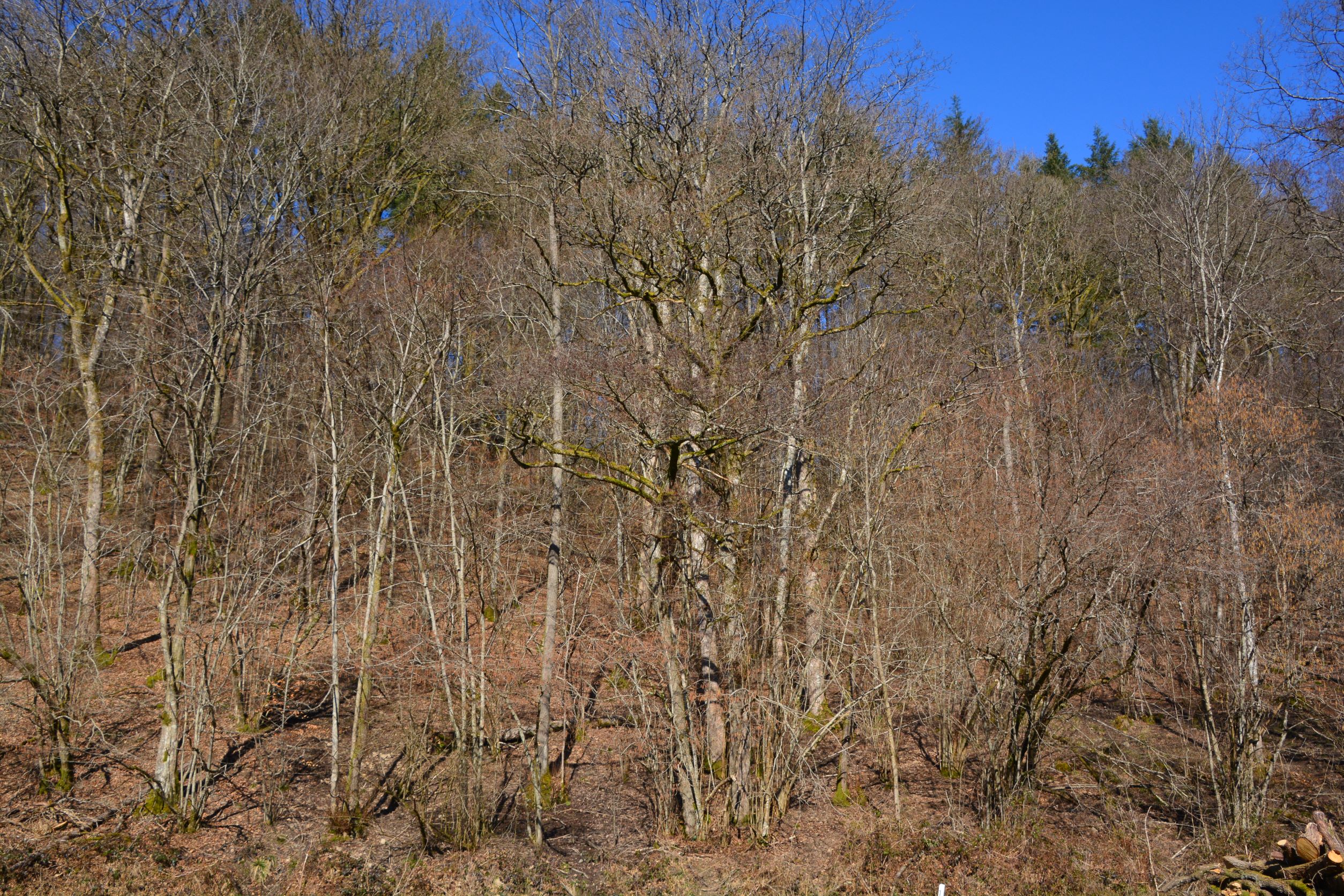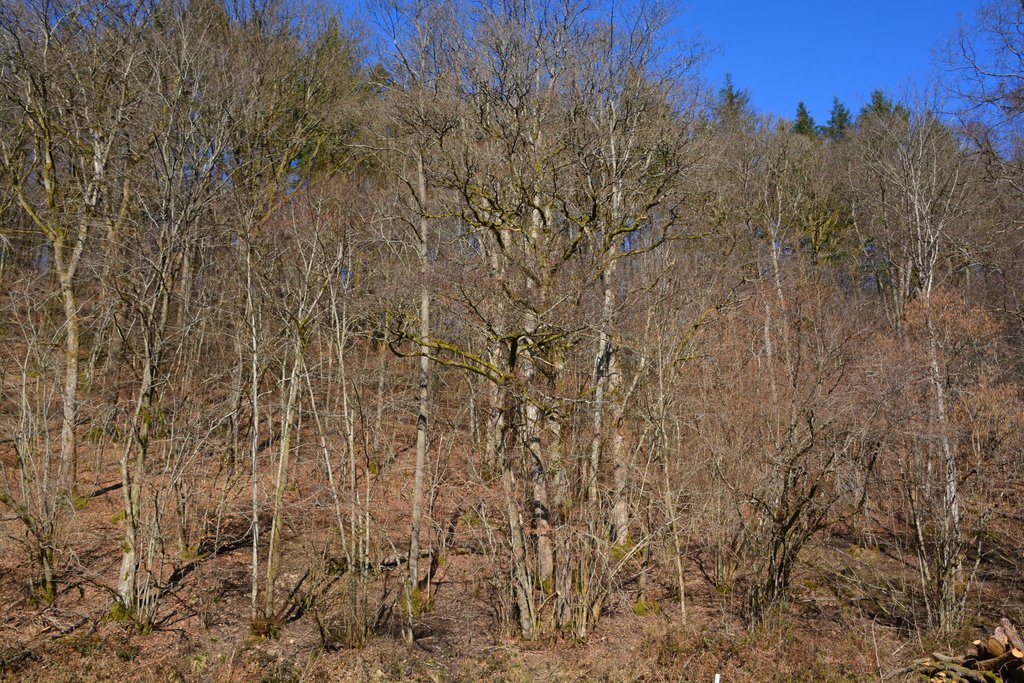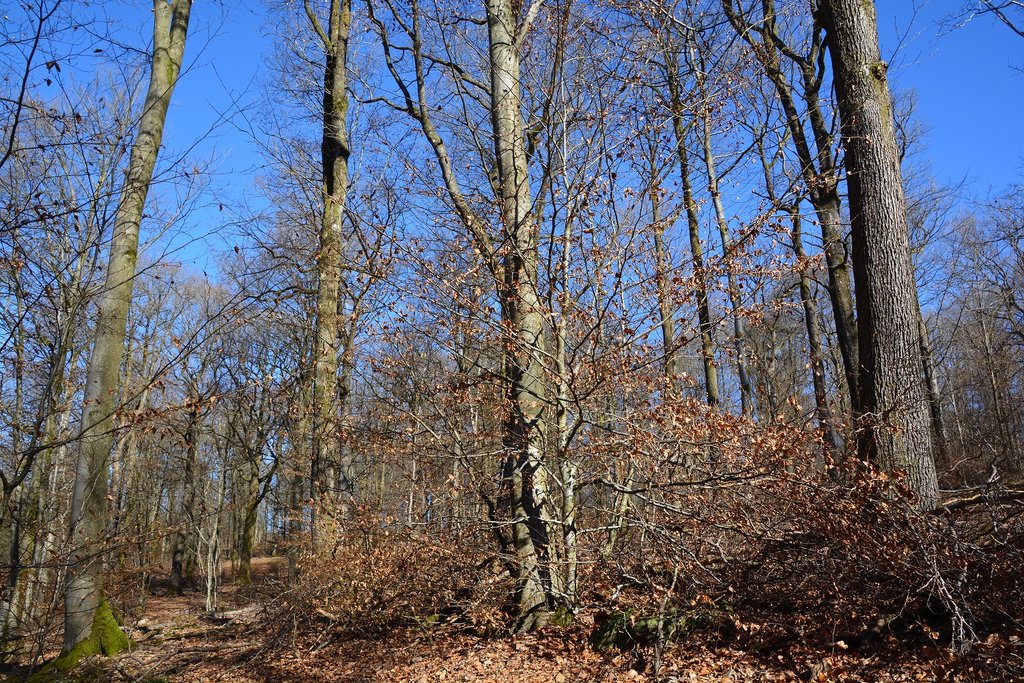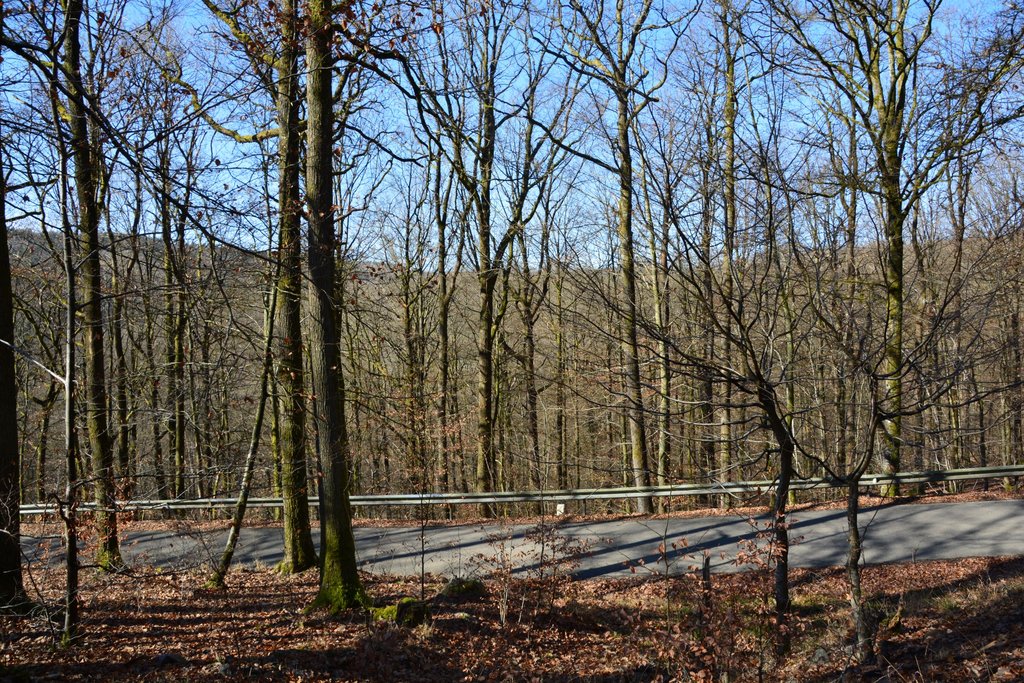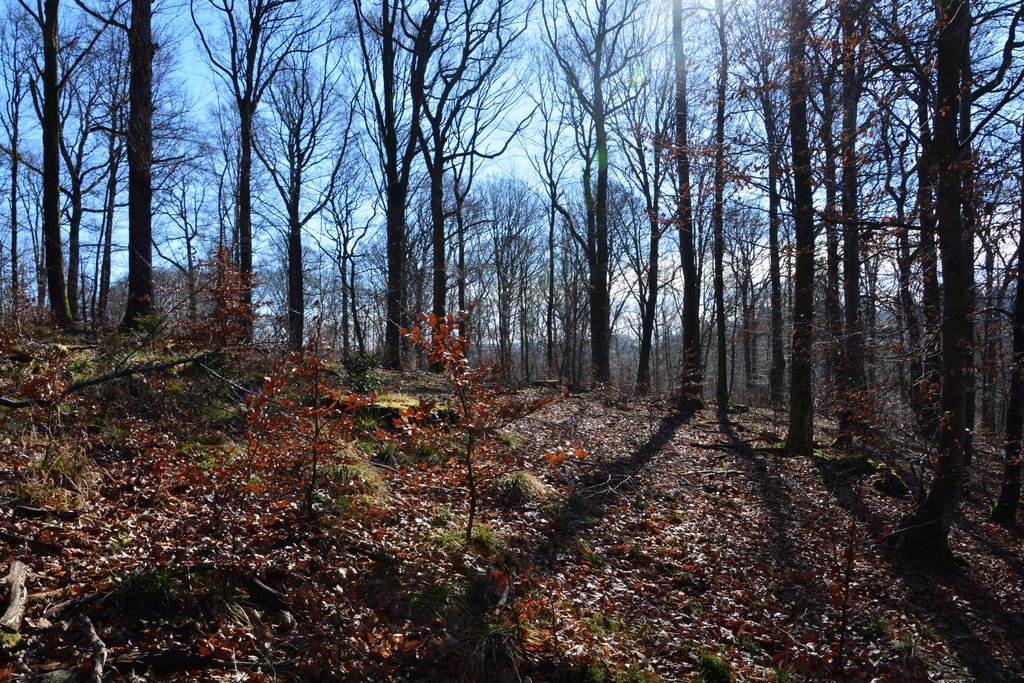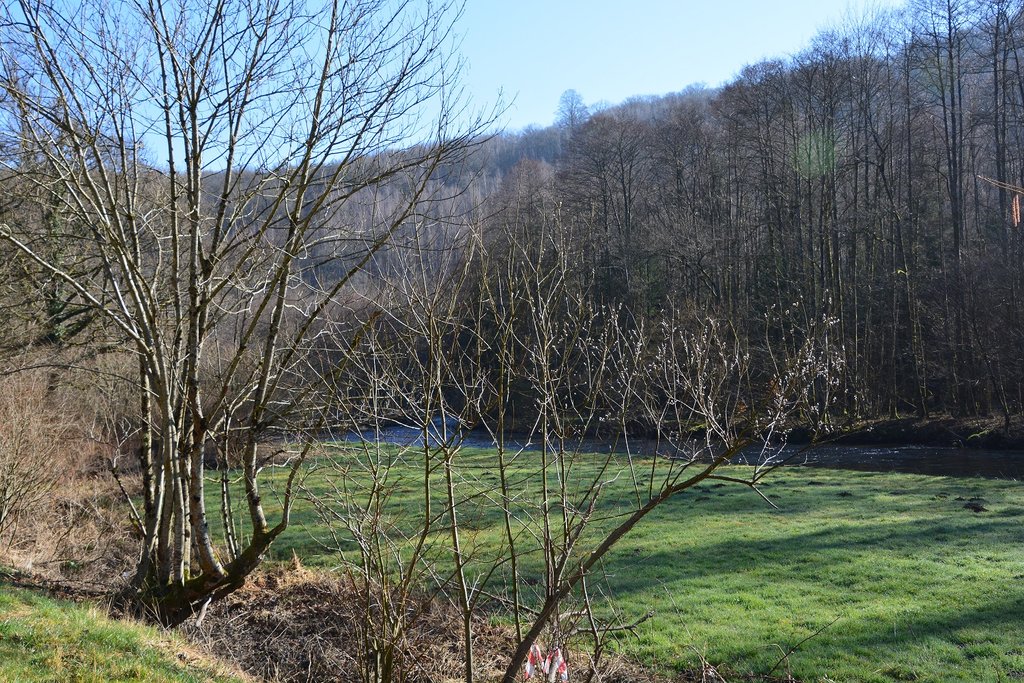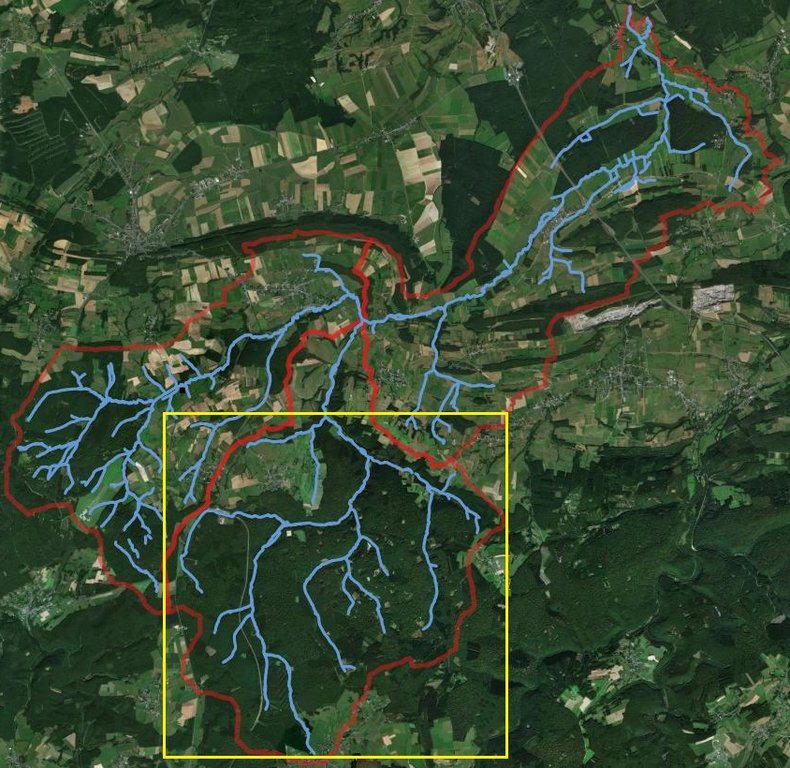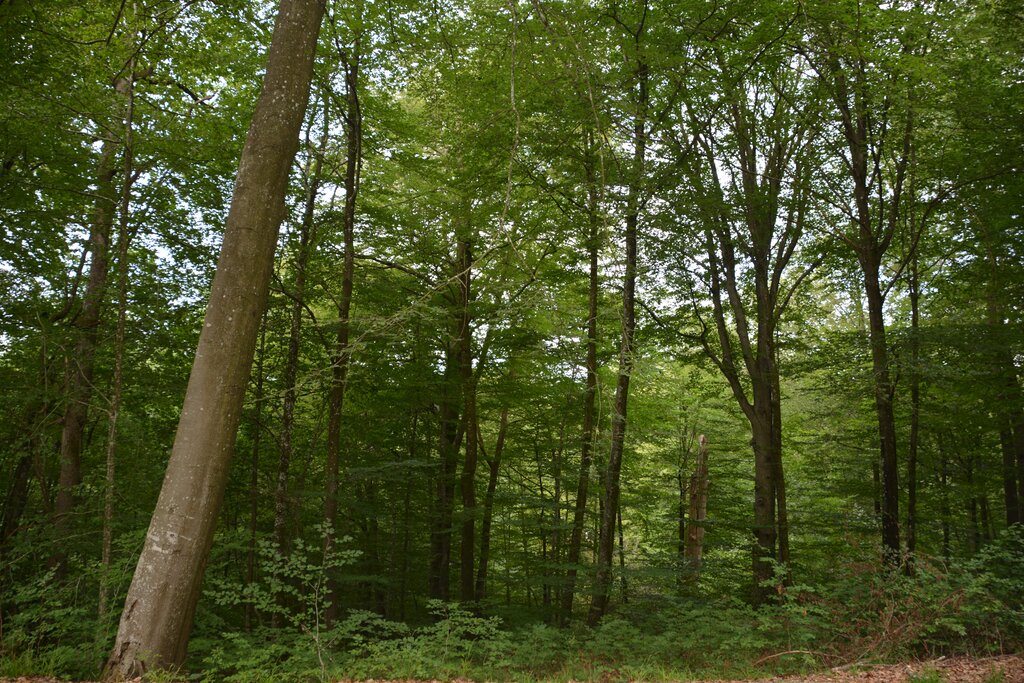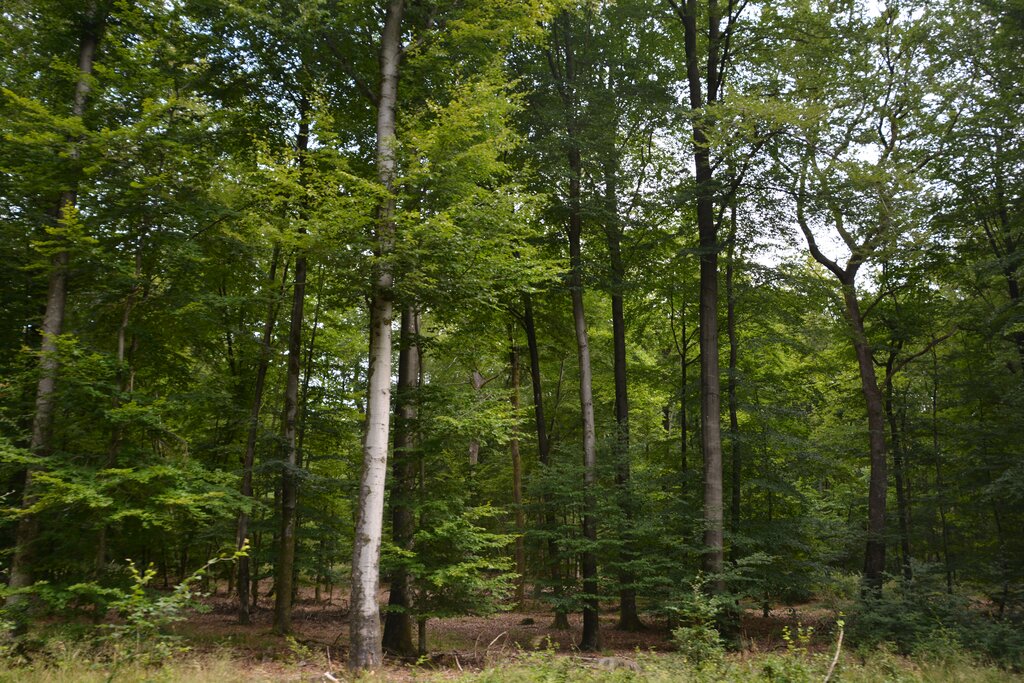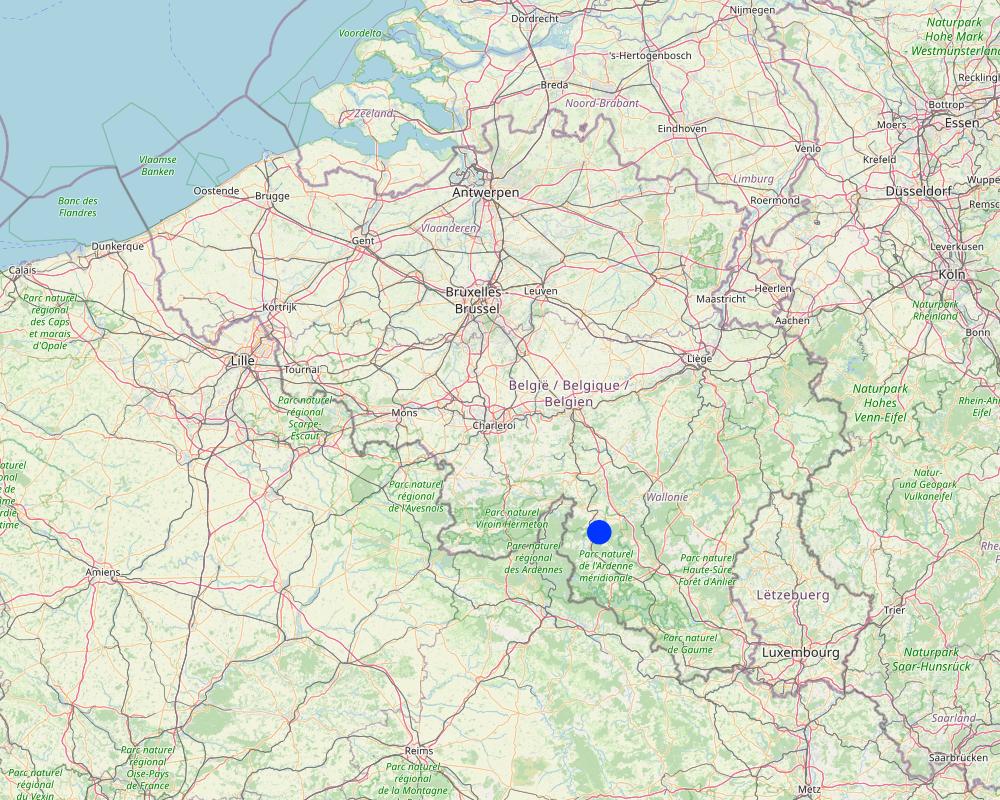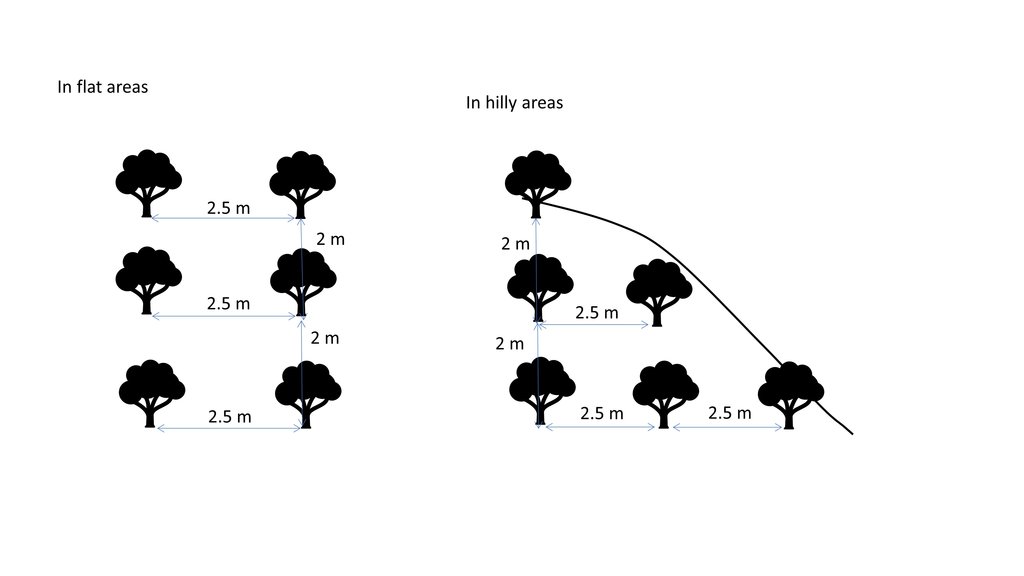Maintenance of forest cover in headwaters [比利时]
- 创建:
- 更新:
- 编制者: Marie Anne Eurie Forio
- 编辑者: –
- 审查者: William Critchley, Rima Mekdaschi Studer
Maintien de la couverture forestière dans les eaux d'amont
technologies_5925 - 比利时
查看章节
全部展开 全部收起1. 一般信息
1.2 参与该技术评估和文件编制的资源人员和机构的联系方式
关键资源人
土地使用者:
Pahaut Bastien
Contrat de Riviere Lesse
比利时
有助于对技术进行记录/评估的项目名称(如相关)
OPtimal strategies to retAIN and re-use water and nutrients in small agricultural catchments across different soil-climatic regions in Europe (OPTAIN)有助于对技术进行记录/评估的机构名称(如相关)
Ghent University (UGent) - 比利时1.3 关于使用通过WOCAT记录的数据的条件
编制者和关键资源人员接受有关使用通过WOCAT记录数据的条件。:
是
1.4 所述技术的可持续性声明
这里所描述的技术在土地退化方面是否存在问题,导致无法被认为是一种可持续的土地管理技术?:
否
2. SLM技术的说明
2.1 技术简介
技术定义:
Forests in headwater areas benefit water quality and hydrologic cycling. Furthermore, maintaining and restoring the forest cover in headwater catchments offers other, multiple benefits such as increased soil water retention, intercepted pollution pathways, improved soil, maintained biodiversity and captured carbon dioxide.
2.2 技术的详细说明
说明:
Forest cover is carefully maintained in the headwater areas of the Wimbe catchment in Belgium. The upstream (headwater) forest covers about 30% of the overall catchment area, which has a total drainage area of 93 sq. km. The trees found in the forest are mainly deciduous species such as oak, linden, birch and beech. A few evergreens/coniferous trees also grow in the area. However, in some parts of the forest, these coniferous trees are being removed/eliminated and replanted with native deciduous species. Furthermore, there is targeted control and removal of damaging invasive alien plants such as Himalayan balsam (Impatiens glandulifera). The forest in the headwater areas provides multiple benefits. First, it enhances water quality as well as regulating the flow regime and hydrological cycling, thereby providing drinking water ecosystem services. Forest soils generally have good infiltration capacity, capturing rainfall, as well as water caught by the canopy and later dripping from the leaves or flowing down the stem. The soils slowly release the rainwater captured, limiting or preventing runoff, and decelerating the rate at which the runoff water travels: maintaining forests is therefore considered to be a retention measure. Forests, in general, also increase evapotranspiration and canopy interception, which contributes to reducing runoff, and increasing precipitation recycling. Furthermore, the forest floor and its soils are generally high in organic matter content, which enhances soil-water retention. Forests also reduce pollutant runoff such as metals and organic contaminants as these pollutants are tightly bound to the organic matter in forest soils. Forest cover can significantly reduce erosion through the dense organic mat which is more resistant to erosion than exposed soils. On top of that, the forest greatly contributes to biodiversity preservation both above ground in growing and decaying vegetation, and within the soil also. Forests capture atmospheric carbon through their growth and associated utilisation of carbon dioxide. Carbon is then held in the wood, but also in the forest floor and in the organic matter-rich soil. The forest provides for tourism and aesthetic values which improves human well-being not only for the local people but also for visitors from outsider.
2.3 技术照片
2.4 技术视频
注释、简短说明:
None
2.5 已应用该技术的、本评估所涵盖的国家/地区/地点
国家:
比利时
区域/州/省:
Wallonie
有关地点的进一步说明:
Daverdisse, Wellin
具体说明该技术的分布:
- 均匀地分布在一个区域
如果不知道精确的区域,请注明大致覆盖的区域:
- 10-100 平方千米
技术现场是否位于永久保护区?:
是
如果是,请具体说明:
Many parts of the forest are Natura2000 sites.
Map
×2.6 实施日期
如果不知道确切的年份,请说明大概的日期:
- 50多年前(传统)
2.7 技术介绍
详细说明该技术是如何引入的:
- 通过土地使用者的创新
- 作为传统系统的一部分(> 50 年)
- 通过项目/外部干预
注释(项目类型等):
The area is originally a forest.
3. SLM技术的分类
3.1 该技术的主要目的
- 减少、预防、恢复土地退化
- 保护生态系统
- 结合其他技术保护流域/下游区域
- 保持/提高生物多样性
- 减缓气候变化及其影响
3.2 应用该技术的当前土地利用类型

森林/林地
- (半天然)天然森林/林地
(半天然)天然森林/林地:具体说明管理类型:
- 清除枯木/剪枝
- 非木材森林的利用
以上的树木是落叶树还是常绿树?:
- 混合落叶或常绿
产品和服务:
- 木材
- 水果和坚果
- 其它森林产品
- 自然保持/保护
- 娱乐/旅游
- 自然灾害防护
3.3 由于技术的实施,土地使用是否发生了变化?
由于技术的实施,土地使用是否发生了变化?:
- 否(继续问题3.4)
3.4 供水
该技术所应用土地的供水:
- 雨养
3.5 该技术所属的SLM组
- 天然和半天然森林管理
- 森林种植管理
3.6 包含该技术的可持续土地管理措施

管理措施
- M3:根据自然和人文环境进行布局
- M5:物种组成的控制/变化
3.7 该技术强调的主要土地退化类型

生物性退化
- Bc:植被覆盖的减少
- Bh:栖息地丧失
- Bs:质量和物种组成/多样性的下降
3.8 防止、减少或恢复土地退化
具体数量名该技术与土地退化有关的目标:
- 防止土地退化
4. 技术规范、实施活动、投入和成本
4.1 该技术的技术图纸
技术规范(与技术图纸相关):
The figure represent the suggested distance between trees when planting trees in hilly and flat terrain.
4.2 有关投入和成本计算的一般信息
具体说明成本和投入是如何计算的:
- 每个技术区域
注明尺寸和面积单位:
0.01 sq. km (1 ha)
其它/国家货币(具体说明):
Euro
如相关,注明美元与当地货币的汇率(例如1美元=79.9巴西雷亚尔):1美元=:
1.0
注明雇用劳工的每日平均工资成本:
280
4.3 技术建立活动
注释:
Additional information can be found in http://biodiversite.wallonie.be/fr/c-actions-de-restauration.html?IDC=6382
4.4 技术建立所需要的费用和投入
| 对投入进行具体说明 | 单位 | 数量 | 单位成本 | 每项投入的总成本 | 土地使用者承担的成本% | |
|---|---|---|---|---|---|---|
| 劳动力 | Planting trees | person-day | 27.0 | 280.0 | 7560.0 | 100.0 |
| 植物材料 | Tree seedlings | pcs | 2000.0 | 2.0 | 4000.0 | |
| 技术建立所需总成本 | 11560.0 | |||||
| 技术建立总成本,美元 | 11560.0 | |||||
如果土地使用者负担的费用少于100%,请注明由谁负担其余费用:
From subsidies
注释:
Depending on the tree species, tree seedling can range from 1USD to 2.5 USD (Given 1 USD=1Euro)
4.5 维护/经常性活动
| 活动 | 时间/频率 | |
|---|---|---|
| 1. | Targeted control of invasive alien plants | once or twice a year |
| 2. | Elimination of isolated softwoods (conifers) | |
| 3. | Clearing of forest clearings | |
| 4. | Planting of native hardwood (deciduous trees), with or without protections |
注释:
https://biodiversite.wallonie.be/fr/c-actions-de-restauration.html?IDC=6382
4.6 维护/经常性活动所需要的费用和投入(每年)
注释:
If the tree seedling dies, then it will have to be replanted again.
4.7 影响成本的最重要因素
描述影响成本的最决定性因素:
The replanting of trees, in general, and in particular eliminating softwoods (coniferous) and replanting of hardwoods (deciduous).
5. 自然和人文环境
5.1 气候
年降雨量
- < 250毫米
- 251-500毫米
- 501-750毫米
- 751-1,000毫米
- 1,001-1,500毫米
- 1,501-2,000毫米
- 2,001-3,000毫米
- 3,001-4,000毫米
- > 4,000毫米
农业气候带
- 半湿润
5.2 地形
平均坡度:
- 水平(0-2%)
- 缓降(3-5%)
- 平缓(6-10%)
- 滚坡(11-15%)
- 崎岖(16-30%)
- 陡峭(31-60%)
- 非常陡峭(>60%)
地形:
- 高原/平原
- 山脊
- 山坡
- 山地斜坡
- 麓坡
- 谷底
垂直分布带:
- 0-100 m a.s.l.
- 101-500 m a.s.l.
- 501-1,000 m a.s.l.
- 1,001-1,500 m a.s.l.
- 1,501-2,000 m a.s.l.
- 2,001-2,500 m a.s.l.
- 2,501-3,000 m a.s.l.
- 3,001-4,000 m a.s.l.
- > 4,000 m a.s.l.
说明该技术是否专门应用于:
- 不相关
5.3 土壤
平均土层深度:
- 非常浅(0-20厘米)
- 浅(21-50厘米)
- 中等深度(51-80厘米)
- 深(81-120厘米)
- 非常深(> 120厘米)
土壤质地(表土):
- 中粒(壤土、粉土)
土壤质地(地表以下> 20厘米):
- 中粒(壤土、粉土)
表土有机质:
- 中(1-3%)
5.4 水资源可用性和质量
地下水位表:
5-50米
地表水的可用性:
好
水质(未处理):
不良饮用水(需要处理)
水质请参考::
地下水和地表水
水的盐度有问题吗?:
否
该区域正在发生洪水吗?:
是
规律性:
偶然
5.5 生物多样性
物种多样性:
- 中等
栖息地多样性:
- 中等
关于生物多样性的注释和进一步规范:
Observations suggest a notable reduction in biodiversity and a decline in forest health over the past few decades, largely driven by forestry and hunting practices that do not always support forest resilience, along with the impacts of climate change and pest and pathogen outbreaks
5.6 应用该技术的土地使用者的特征
定栖或游牧:
- 定栖的
生产系统的市场定位:
- 商业/市场
相对财富水平:
- 平均水平
个人或集体:
- 个人/家庭
- 团体/社区
机械化水平:
- 手工作业
- 机械化/电动
性别:
- 女人
- 男人
土地使用者的年龄:
- 中年人
- 老年人
5.7 应用该技术的土地使用者使用的平均土地面积
- < 0.5 公顷
- 0.5-1 公顷
- 1-2 公顷
- 2-5公顷
- 5-15公顷
- 15-50公顷
- 50-100公顷
- 100-500公顷
- 500-1,000公顷
- 1,000-10,000公顷
- > 10,000公顷
这被认为是小规模、中规模还是大规模的(参照当地实际情况)?:
- 小规模的
5.8 土地所有权、土地使用权和水使用权
土地所有权:
- 州
- 个人,有命名
土地使用权:
- 社区(有组织)
- 个人
用水权:
- 社区(有组织)
土地使用权是否基于传统的法律制度?:
是
注释:
Land ownership here applies to the single sites.
5.9 进入服务和基础设施的通道
健康:
- 贫瘠
- 适度的
- 好
教育:
- 贫瘠
- 适度的
- 好
技术援助:
- 贫瘠
- 适度的
- 好
就业(例如非农):
- 贫瘠
- 适度的
- 好
市场:
- 贫瘠
- 适度的
- 好
能源:
- 贫瘠
- 适度的
- 好
道路和交通:
- 贫瘠
- 适度的
- 好
饮用水和卫生设施:
- 贫瘠
- 适度的
- 好
金融服务:
- 贫瘠
- 适度的
- 好
6. 影响和结论性说明
6.1 该技术的现场影响
社会经济效应
生产
森林/林地质量
注释/具体说明:
Forest provide wood products (Verkerk et al., 2015)
Pieter J. Verkerk, Christian Levers, Tobias Kuemmerle, Marcus Lindner, Ruben Valbuena, Peter H. Verburg, Sergey Zudin, Mapping wood production in European forests, Forest Ecology and Management Volume 357, 2015, pages 228-238,ISSN 0378-1127, https://doi.org/10.1016/j.foreco.2015.08.007
水资源可用性和质量
饮用水的可用性
饮用水的质量
注释/具体说明:
Healthy forest provide various ecosystem services such as drinking water production as they can filter out water pollution, regulate stream flows, recharge aquifers, and absorb flooding (Jenkins and Schaap, 2018).
Reference:
Jenkins, M., & Schaap, B. (2018). Forest ecosystem services. Background analytical study, 1.
社会文化影响
健康状况
土地使用权/用水权
文化机会
娱乐机会
注释/具体说明:
Forests provide recreation opportunities through tourism improving the health and well being of humans.
SLM/土地退化知识
注释/具体说明:
Forest prevents land degradation ( (Jenkins and Schaap, 2018).
Reference:
Jenkins, M., & Schaap, B. (2018). Forest ecosystem services. Background analytical study, 1.
生态影响
水循环/径流
水量
水质
地表径流
土壤
土壤水分
土壤覆盖层
土壤流失
土壤有机物/地下C
生物多样性:植被、动物
植被覆盖
生物量/地上C
植物多样性
动物多样性
有益物种
栖息地多样性
注释/具体说明:
Forest supports biodiversity
减少气候和灾害风险
滑坡/泥石流
干旱影响
碳和温室气体的排放
微气候
6.2 该技术的场外影响已经显现
水资源可用性
旱季稳定可靠的水流
下游洪水
注释/具体说明:
Decrease in downstream flooding is a positive thing
下游淤积
地下水/河流污染
缓冲/过滤能力
温室气体的影响
6.3 技术对渐变气候以及与气候相关的极端情况/灾害的暴露和敏感性(土地使用者认为的极端情况/灾害)
渐变气候
渐变气候
| 季节 | 增加或减少 | 该技术是如何应对的? | |
|---|---|---|---|
| 季雨量 | 冬季 | 增加 | 非常好 |
气候有关的极端情况(灾害)
气候灾害
| 该技术是如何应对的? | |
|---|---|
| 极端冬季条件 | 好 |
| 干旱 | 好 |
水文灾害
| 该技术是如何应对的? | |
|---|---|
| 比较和缓的(河道)洪水 | 好 |
6.4 成本效益分析
技术收益与技术建立成本相比如何(从土地使用者的角度看)?
短期回报:
积极
长期回报:
非常积极
技术收益与技术维护成本/经常性成本相比如何(从土地使用者的角度看)?
短期回报:
积极
长期回报:
非常积极
6.5 技术采用
- 1-10%
6.6 适应
最近是否对该技术进行了修改以适应不断变化的条件?:
否
6.7 该技术的优点/长处/机会
| 编制者或其他关键资源人员认为的长处/优势/机会 |
|---|
| Enhances biodiversity. |
| Promotes tourism |
| Maintains good water and air quality |
6.8 技术的弱点/缺点/风险及其克服方法
| 编制者或其他关键资源人员认为的弱点/缺点/风险 | 如何克服它们? |
|---|---|
| Land not used for farming agricultural crops. |
7. 参考和链接
7.1 信息的方法/来源
- 实地考察、实地调查
2
- 与土地使用者的访谈
1
- 与SLM专业人员/专家的访谈
1
- 根据报告和其他现有文档进行编译
3
(现场)数据是什么时候汇编的?:
15/02/2022
7.2 参考可用出版物
标题、作者、年份、ISBN:
No related publications
7.3 链接到网络上的相关信息
标题/说明:
Individual NWRM Maintenance of forest cover in headwater areas
URL:
http://nwrm.eu/sites/default/files/nwrm_ressources/f2_-_maintenance_of_forest_cover_in_headwater_areas_0.pdf
标题/说明:
Restore Actions
URL:
http://biodiversite.wallonie.be/fr/c-actions-de-restauration.html?IDC=6382
7.4 一般注释
The database provide interesting information.
Just comment on the questionnaire. Some questions does not use the same units all throughout, for example in some case it uses km2, sometimes hectare. Maybe better that it will be consistent?
Response: Thanks. I have changed the ha unit into sq. km.
链接和模块
全部展开 全部收起链接
无链接
模块
无模块


